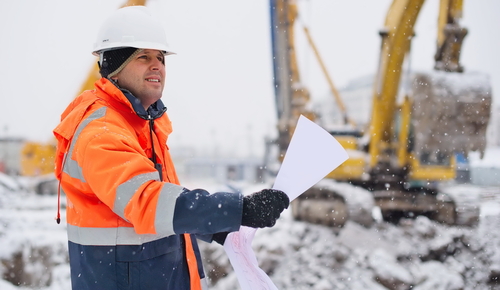Winter is almost upon us. The daylight hours are dwindling and unsettled weather looms ominously on the horizon.
Yet for many organisations, this dark and chilly season creeps up, evading forethought about the risks it poses to safety, health and general well-being in the workplace.
Don’t be one of them.
Now is the time to begin focusing your staff on winter working, with carefully deployed communication that engages them in preparation for the frosty few months ahead.
Here are five typical winter working hazards, plus suggestions on how you can communicate with staff to minimise risk, in an engaging and inspirational way.
1. Daylight-saving changes
The clocks go back at 2am on the last Sunday of October in the UK. That’s not too far away, so now’s the time to flag it up in your toolbox talks as the date approaches.
Staff won’t just appreciate being reminded that they get an extra hour in bed too. They’ll be safer and happier if you craft your messages around what reduced daylight actually means for them, right where they work.
That could mean adequate lighting in places like car parks and covered walkways – so timely illumination gets installed or replaced before things get too dim. It also affects shift patterns and how alert (or tired) people feel.
Posters make excellent reminders of upcoming daylight changes. Make them contextual and put them up well in advance of when the clocks change.
2. Ice
Every aspiring organisation strives for when staff transfer their knowledge of workplace safety into the home. That link between work, life and wellness is cemented, and winter’s a perfect opportunity to encourage a similar shift in mindset.
Perhaps you could create campaign branded packs of de-icing salt for people to take home with them? This isn’t only useful, it’s proof that you’re committed to their well-being (and their families’) both in the workplace and at home.
3. Adverse weather conditions
Toolbox talks or workplace huddles are your chance to remind staff about the ever-changing risk landscape. But do weather reports already feature in yours?
Probably not when conditions are fine.
If you’re familiar with British winters, you’ll know just how ‘variable’ conditions can be, and how frequently they change – often within minutes. Surprisingly, some organisations report that a chief cause of incidents in recent years wasn’t snow or ice. It was high winds, blowing hoardings, fences or other loose material onto pedestrian routes and highways. Floods are an increasing hazard these days too.
So invite a team member to be responsible for monitoring weather forecasts. Empower them to take charge in the planning process for exposed activities. Let them lead huddles and carry out checks at the beginning and end of each day.
Email bulletins or text message updates are a useful way to communicate timely weather reports to staff who work remotely.
Ask staff where they’ve felt most exposed at work, in areas like rooftops and scaffolds. What improvements would they suggest to keep them comfortable, safe and focused on the job?
When you’ve gathered their ideas, you could have them printed onto a pocket-sized winter working checklist, or better still a branded hand-warmer or mug.
4. Illness
Winter is traditionally a time when we seek shelter from the elements, and enjoy a few homely comforts. And there’s no reason why you can’t extend those seasonal sentiments to the workplace.
Use this opportunity to get creative with communicating the importance of health and well-being. You could put hearty food on a winter working themed menu in the staff canteen, to fortify against colds and flu, for example.
Likewise, are your staff up to speed with your policy on absence and ill-health? Chances are they don’t spend their coffee break reading your employee handbook, so now’s the time to remind people of your organisation’s attitude to illness.
Do you suspect there’s an unhelpful culture of ‘manning up’ at work, even if you’re injured or sick? If so, tell people that’s not where you want to be. Feeling poorly but soldiering on is a dangerous distraction with serious consequences.
Well-timed refresher campaigns, before the coughs and sneezes begin, can also help reduce the spread of infections and get ill staff back into work quicker, after a healthy convalescence.
5. Shutdown and return to work
However you celebrate the festive period, it’s important to carefully manage the wind-down and wind-back-up to work. That’s because unfamiliar or infrequent duties like closing down equipment become so much more hazardous when staff have one eye on the mince pies.
At Tribe, we’ve had great results experimenting with the theatrical nature of the festive season. For one client, we hosted a pantomime based on Dickens’ ‘Christmas Carol’, where the ghosts explored the consequences of workplace behaviours and what that meant for Christmas past, present and future. Our client’s staff still talk fondly of ‘Is this the way to triple zero’ sung to the tune of Tony Christie’s hit song of a similar title.
Perhaps this sounds a little too experimental, if you’ve yet to see the benefits of our unique blend of art and science. Yet the crucial point we’re making is that you must be bold and creative if you want to grab and hold the attention of your staff. Especially at this often gloomy time of year.
Winter is coming
Smart organisations realise that a timely, proactive and employee-led approach to winter working practices is how you protect their well-being, as well as your hard-earned record for safety, productivity and quality.
And, as this article clearly demonstrates, it needn’t be a challenge to get people aware of, and fully behind your campaigns, when you try a fresh, inventive approach.
Just remember to act now, before the nights close in.







